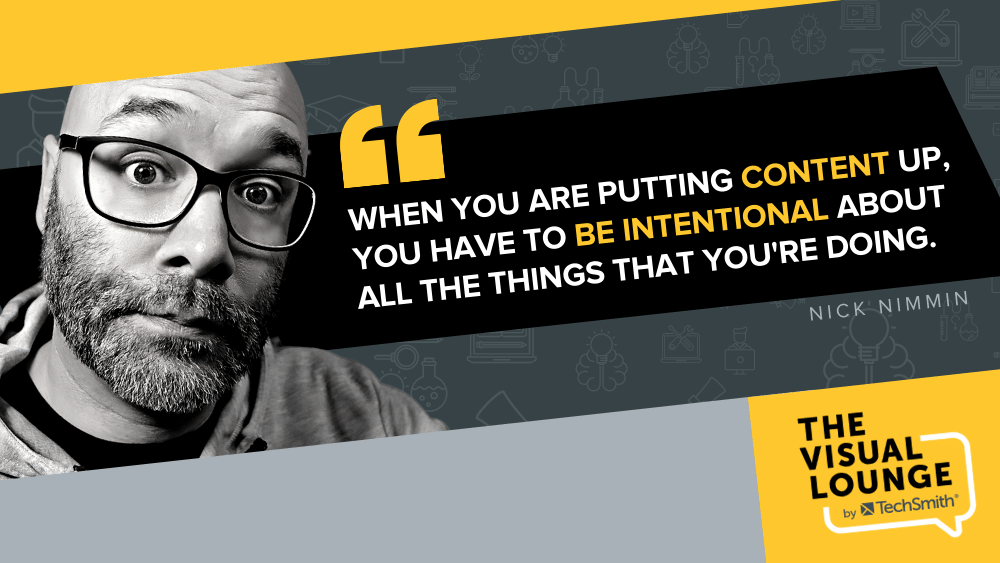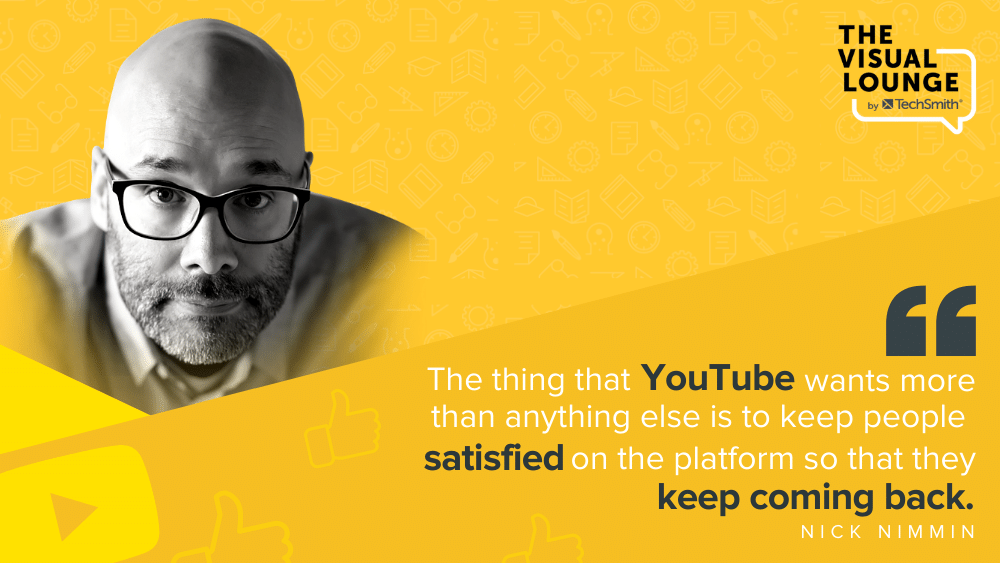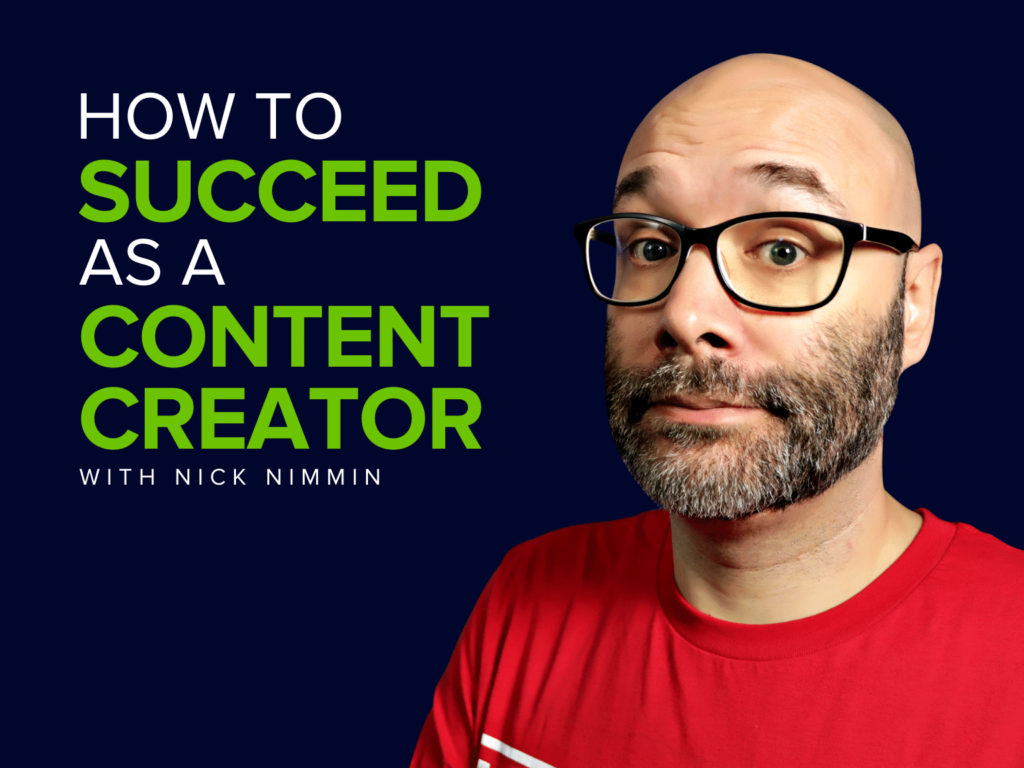Are you ready to take the plunge and become a YouTube content creator?
Before you wing it and hope for the best, you need to know the best practices. Luckily, we’ve got you covered.
In this episode of The Visual Lounge, we invited Nick Nimmin, a YouTube content creator and educator, who’s seen great success on the platform with over 800,000 subscribers and counting!
Nick is passionate about the power of YouTube and online video to help people connect with an audience, expand influence, and grow their businesses.
In this episode, he teaches the best ways to get ahead on YouTube, how to boost viewer retention, how to figure out the mystical algorithm, and everything else you need to know about the platform. This episode is packed full of tips and actionable advice for budding YouTubers and experienced content creators alike.
You can watch the video on this topic at the top of this post, to listen to the podcast episode, hit play below, or read on for more…
The learning curve of YouTube
Being a YouTuber is an increasingly popular dream for many. But what a lot of people don’t realize is that it’s a whole lot of work if you want to be successful.
Those who manage to get ahead are willing to put in the work to learn more about their camera gear, editing software, and YouTube algorithms.
Nick’s advice for anyone interested in starting on YouTube is to just go for it as soon as you can. The sooner you start, the more time you’ve given yourself to get through that learning curve.
“You have to dedicate some time to making sure that you are fully learning how to use your camera or learning how to upload videos to YouTube or optimize your videos or learning how to get your audience to click on what it is that you’re doing.”
Business lessons from YouTube
It’s clear by now that successful YouTubers aren’t just people who ramble into a camera. Many are smart business people, who have found a strategy that works, so we can take plenty of business lessons from them.
The biggest lesson everyone needs to learn, says Nick, is understanding who your audience is. Once you know who your audience is, you can start to be really intentional about how you target them.
Contrary to popular belief, YouTube isn’t a place where “winging it” gets you very far. You might get lucky and have some success with a few videos. But if you want sustained success, you need a strategy, and that all starts with your audience.
YouTube is just like any other business, Nick says. You need to please your customers or viewers in this case. To do that, you need to know how to fix their problems, entertain them, or provide another reason that will keep them watching.

Knowing your audience
If you’re using YouTube to market your business or products, it’s a case of looking at who your ideal customer is. For example, if you were promoting Camtasia, you’d have to look into what value that provides for users. What problem it solves, the type of people who would use it the most, and who wouldn’t use it as well.
However, before you even get to that stage, there’s another thing you need to do – decide what you want your YouTube channel to actually do.
Are you trying to sell products or increase website traffic? Do you want to build a community? Are you looking to become The Next Big Thing?
By determining what you really want out of YouTube, you’ll be able to define your audience based on that. You can then think about what types of content will appeal to that audience and get you closer to where you want to go.
“If you’re trying to get famous in that case, you probably don’t want to spend tons of time doing content on some obscure software that nobody uses.”
On the other hand, if you’re trying to sell something to your community, you might take a completely different approach to your content.
Figuring out what type of content to make
Getting a clear idea of your audience is one thing, but when it comes to the content itself, how do you know what to focus on?
One of the first things to do is hop on YouTube and see what other people are doing. What is your competition doing to reach that audience? This gives you a good idea of the kind of content that people like seeing.
Other ways to find video ideas are on Facebook groups or Reddit to see what people ask or discuss. You could ask people what their biggest struggle is or what they love to see in video content.
Another trick is to look at the autocomplete feature in the YouTube search bar. Start typing a topic, and you’ll see what other people have searched for, just like on Google.
This type of topic research will help you narrow down your focus and create content that people are already looking for. Then, all that’s left is to deliver that much-needed content.
Start creating professional-looking YouTube videos today with five free essential motion graphics templates for Camtasia created by YouTube expert Nick Nimmin.
Get Started
Recommendations vs. search
Now, if you’ve researched how to get ahead on YouTube already, you’ll have heard of optimizing for search. This means you’re optimizing your video and channel so that your audience finds it easily.
This is simple enough to do, and eventually, you’ll see your videos views going up.
But that’s not the only thing you want to do. Nick says that you should look at recommendations as well. That’s when all those videos pop onto your home page or suggested videos. These videos get a whole lot of hits, but only if they stand out.
To stand out on a recommendations page, you need a good thumbnail and title. On this page, you’re not appealing to people who have searched for your video. You’re appealing to people who had no intention of watching your video – which is much harder.
“When it comes to the recommendation features, it’s more difficult because those people aren’t expecting to watch the content. So you have to get really good at helping people identify that the content you’re making is something that they might be interested in. You can do this through your title and your thumbnail, and pull that user from the homepage or from suggested videos.”
How to define success on YouTube
How do you define success on a platform like YouTube? Nick thinks that you need to ask yourself, what are you trying to do on YouTube?
Success isn’t defined by having one million views minimum on each video – unless that’s your goal. Success might look like 400 views and two people joining your email list after watching a video. Maybe you define success by the number of subscribers you have or the sales you make.
Nick says that too many people lose focus on stuff that isn’t really relevant. For example, if you’re on YouTube to sell as many products as possible, you might get caught up in the number of comments on your videos. So, you might pull focus from your real goal and try to get more comments instead, which might be a waste of time.
However, he does say that the one metric that everyone should be looking at is view counts.
“Views are always important because no matter what it is that you’re trying to accomplish on your YouTube channel, views are the only things that are going to help you do it.”
Subscriber count is important, but you probably shouldn’t obsess over it as some people do. All that does is distract your attention.
“Instead of focusing so hard on trying to get people to subscribe to your channel, it’s way more important to try to focus on delivering content that adds value to people and that people actually enjoy. So you can get them to watch more than one video at a time.”
Boosting retention
Viewer retention is good news for everyone. You get more views and subscribers, YouTube is happy about all that ad revenue, and hopefully, your viewer gets what they need.
But retention is a tough one to crack. There are millions of other videos on the platform, so how do you get them to watch yours next?
One feature that YouTube has is the in-screen videos that you have at the end. You can put some of your other relevant videos here to prompt the viewer to watch those next. But it’s not that simple. Nick warns about a common mistake…
When you wrap your video up, you naturally start to use finalizing language. This signals to your viewer that the video is over. They typically click away at this point and never see your in-screen links. Nick suggests wrapping the video up while those links are on the screen, so no one misses them.
When you boost retention like this, it signals to YouTube that people love your content. They’ll start to recommend it more which results in more people seeing your content.
Taking advantage of the Community tab
The Community tab on YouTube is a handy, if not underutilized, feature for YouTubers. There are a few things you can do with it. For example, you could share an old piece of content that people might have missed the first time around. You can share what content you’ve got planned to build excitement.
You can also ask your community what they’re struggling with or even just ask for video ideas. This is a direct way to give your audience what they want.
Another example that Nick used was when he asked whether people identified more as a “YouTuber” or a “content creator.” Most people said content creator, so he started using that term more often in his video titles to better connect with his audience.

The challenges of niching down
YouTube content creators need to contend with the algorithm at all times, but there’s one challenge that’s tricky to overcome.
If you’re thinking of creating content that’s a bit different than your usual stuff, hold on!
Bear in mind that if you create videos that your usual audience doesn’t like, those videos will essentially be demoted by YouTube. Create more and more of them, and YouTube may not take kindly to your channel.
So, doing different things can be a double-edged sword. Your community may love it, in which case, that’s great. But even then, this can confuse the algorithm. What about your older content?
So, Nick suggests being careful with any pivots and keeping in close contact with your audience.
To hear more words of wisdom from Nick, watch or listen to the full conversation at the top of this page. Or, if you want even more help and guidance on content creation, head over to TechSmith Academy. You’ll find plenty of tips and guides on equipment and video editing software to help you level up your skills.



Share